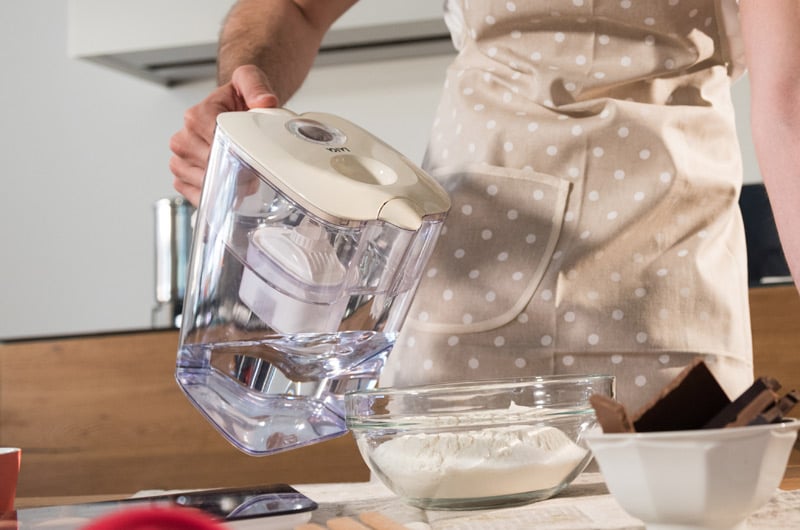Using a filter jug for your hydration needs is a practical and, above all, environmentally friendly choice. With a filter jug, you can avoid using single-use plastic bottles and enjoy the convenience of tap water at any time. And, as we have mentioned in a number of articles, it offers significant savings in terms of time and money.
However, sometimes you may see some small black specks, tiny little particles, near the filter in the jug or in the glass. Where do they come from? Are they harmful to health? Let’s take a look at the answers.
How a filter jug works

Before we explain what this “black dust” is that appears around the filter and on the bottom of the filter jug, let’s take a moment to remember that a filter jug is normally made up of three main parts:
- The tank which is filled up with tap water
- The jug body which contains filtered water ready to be poured and drunk
- The filter (or cartridge) which connects the two tanks and which filters the water as it passes from one to the other
Choosing a filter jug is easy, there are all sorts of types, shapes and colours on sale. However, the part that really makes the difference is, without doubt, the filter.
It is the filter and its properties which determine the effectiveness of the filtration, determining the final taste of the water. For example, the water from the tap can often have an unpleasant “bitter” taste due to the chlorine used in the pipes, but this problem can be overcome by simply filtering the water, giving us drinking water which tastes good and fresh in just a few steps.
There are many different types of filters on the market, each of which fulfils different requirements: some are aimed at reducing limescale, others are more suitable for filtering out microplastics, then there are those that remove chemical contaminants and pesticides.

One very important consideration is the ability of the filter to remove unwanted substances whilst retaining the mineral salts which our bodies need that are naturally present in tap water. This is a crucial aspect which, too often, is under-appreciated by people who are new to the world of domestic filtration. People who are used to drinking filtered water, however, value the mineral salts parameter highly.
Even though there are many different types of filter available, users sometimes report finding a dark residue in the filter jug around the cartridge or in the water when poured into a glass.
What is this? What are these tiny particles that appear?
“Black specks” in the filter jug: what are they

Dark residue, black dust, minute particles. These are just some of the words used in online reviews and comments to describe those little particles on the bottom of the filter jug. What are they?
Usually, the filters used in filter jugs use what is known as “activated carbon” technology. Those tiny fragments are simply granules of the activated carbon that fill the filter cartridge.
They can appear when the cartridge is being activated and, occasionally, after prolonged use of the filter jug with the same filter: put simply, tiny fragments of activated carbon leak out of the filter.
Filter jugs and health: are these particles dangerous?
It is worth pointing out that a filter or a filter cartridge should not continually leak fragments of activated carbon. The small black specks should only appear sporadically, from time to time.
Every filter and cartridge is usually tested in specialist laboratories which assess every parameter of the product: at the moment, we can confirm that occasionally ingesting small fragments of activated carbon should not cause any health problems. Our body is capable of eliminating these fragments on its own, without causing any inflammation or complications.
In conclusion, let’s take another look at how to correctly use a filter jug and how to deal with the appearance of any tiny black particles:
- Follow the instructions contained in the product packaging to correctly activate the filter/cartridge (at this stage, some tiny fragments may come out).
- Ensure that the filter is correctly fitted inside the filter jug
- Fill the filter jug tank with tap water and wait for it to be filtered
- When the jug body is full of filtered water, the filter jug is ready for end use (at this stage, small, dark fragments may appear near the filter which are easy to remove)
For any queries, the advice is to contact the customer service department of the manufacturer of the filter jug or filter.

It's your turn, leave your comment!
Get the latest from the Laica blog